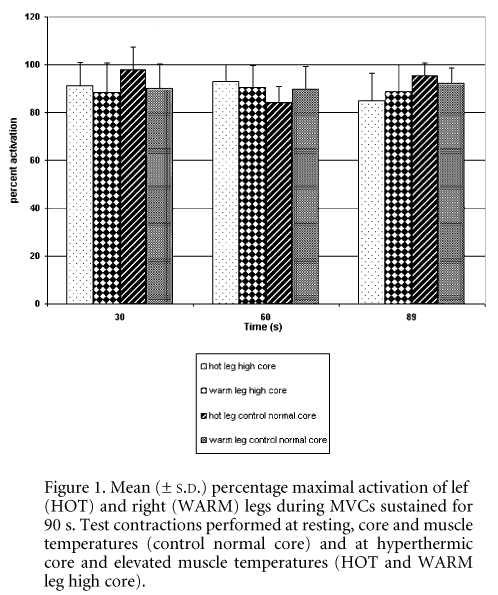Exercise-induced hyperthermia has been linked to failure to activate the exercised muscles during subsequent sustained isometric contractions (Nybo & Nielsen, 2001). We have examined whether hyperthermia is associated with failure of voluntary activation of human calf muscles under properly controlled conditions. We used passive heating in a hot water bath to elevate body core temperature to avoid the confounding effects of prior exercise on muscle function tests. Further, to control for temperature effects on muscle fatigue and afferent feedback we compared responses of both legs which were heated to different temperatures. This was achieved by supporting the lower leg of one limb above water level (WARM) whilst the other limb was immersed in the water (HOT).
Gastocnemius temperatures were measured by indwelling thermocouples and body core temperature by a rectal probe. Muscle function was assessed using standard equipment (Davies & White, 1982) from the decline of force during a 90 s isometric maximal voluntary contraction (MVC). Muscle activation level was assessed from EMG and the size of any additional force evoked by the interpolation of a supramaximal tetanic stimulus (300 ms, 100 Hz) delivered to the triceps surae at 30, 60 and 89 s. With local ethics committee approval, five male subjects were habituated to the procedures prior to entry to the trial. Control measures were performed on each leg at resting core temperatures. On another day subjects were instrumented and placed in a hot water bath to the level of the upper chest wearing a waterproof hooded jacket to cover the head, upper body and arms. This garment was worn throughout the subsequent testing period.
Hot water immersion elevated core temperature (mean ± S.D.) to 39.52 ± 0.27 °C and HOT leg temperature to 40.26 ± 0.30 °C just prior to testing and 39.17 ± 0.16 and 37.11 ± 0.22 °C, respectively, for the WARM leg which was tested last.
Figure 1 shows activation levels in control and hyperthermic contractions for both limbs. ANOVA revealed a significant time effect on activation level in control, HOT and WARM limbs (P < 0.05), but no effect of hyperthermia on voluntary activation and no difference between HOT and WARM.
Our results indicate a small progressive decrease in the activation level of the calf muscles during a sustained MVC in both control and hyperthermic conditions, though at worst activation is still in excess of 84 % in control conditions and 85 % in hyperthermia. We conclude that passive elevation of body core temperature to hyperthermic levels and elevation of muscle temperature to above 40 °C has no significant effect on the ability of subjects to activate their previously passive calf muscles.
All procedures accord with current local guidelines and the Declaration of Helsinki.

